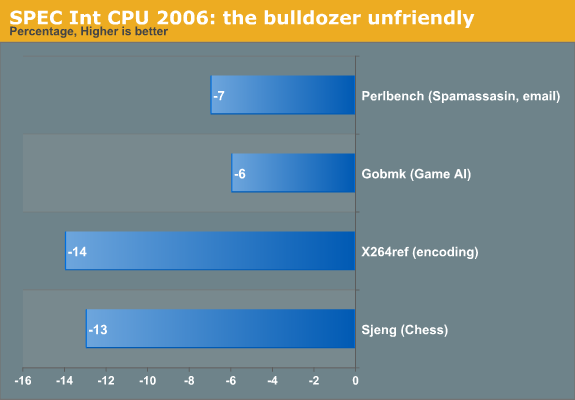The Bulldozer Aftermath: Delving Even Deeper
by Johan De Gelas on May 30, 2012 1:15 AM ESTZooming in on SPEC CPU2006: the Bad
The optimized SPEC CPU2006 int binaries allow gains in the range of 30% to 117%. Unfortunately the complete benchmark suite only shows a gain of 21% when we compare the Opteron 6276 with the 6176. Closer inspection shows that four benchmarks regress. The regression appears to be small in most benchmarks (7 to 14%), but remember that we have 33% more cores. Even a small regression of 7% means that we are losing up to 30% of the previous architecture's single-threaded performance!

Perlbench has high locality in the L1 and L2 caches and rarely accesses the Last Level Cache, let alone the memory. The result is a benchmark that delivers high IPC: 1.67 on a five year old Core 2 Duo ("Merom"), and close to +/- 1.9 IPC on the latest Intel CPUs. The interesting thing to note is that h264ref and Perlbench are among the top IPC performers in the SPEC CPU2006 suite.
Sjeng (chess) and Gobmk are both Artificial Intelligence subroutines. Again, the IPC is relatively high (>1), but their most important performance characteristic is that they contain a very high percentage of hard to predict branches: twice the average of the SPEC CPU integer suite.
Granted, the evidence we've presented is still circumstantial. It would take an extremely long and intensive profiling session on all new processors to really determine what is going on, and that is beyond our time budget: one SPEC CPU run alone consumes a whole day. However, we did get our hands dirty. A short profiling session on three different benchmarks gives us some very interesting results that we want to discuss next.










84 Comments
View All Comments
ArteTetra - Wednesday, May 30, 2012 - link
"A core this complex in my opinion has not been optimized to its fullest potential. Expect better performance when AMD introduces later steppings of this core with regard to power consumption and higher clock frequencies."You don't say?
JohanAnandtech - Thursday, May 31, 2012 - link
A quote by a reader, not ours :-). The idea is probably that Bulldozer was AMD's very first implementation of their new architecture.haplo602 - Wednesday, May 30, 2012 - link
now this was a great read. finaly something interesting (the consumer benchmarks are NOT intereseted anymore for me).I hope there will be a differential analysis once you have Piledriver CPUs available.
JohanAnandtech - Thursday, May 31, 2012 - link
Piledriver analysis: definitely. Thanks for the encouraging words :-)mikato - Friday, June 1, 2012 - link
I agree - great critical thinking in this article! This subject definitely needed more research.Spunjji - Wednesday, June 6, 2012 - link
+1. This is the sort of thing I come here for!Beenthere - Wednesday, May 30, 2012 - link
Expecting Vishera to be an Intel killer is foolish as it's not going to happen and there is no need for it to happen. Ivy Bridge is very much like FX in that it's only 5% faster than SB and runs hot. At least FX chips OC and scale well unlike Ivy Bridge.If AMD can use some of the techniques imployed in Trinity they should be able to get a 15+% improvement over the FX CPUs. This combined with higher clockspeeds now that GloFo has sorted 32nm production should provide a nice performance bump in Vishera.
95% of consumers do not buy the fastest, most over-hyped and over-priced CPU on the planet for their PC or server apps. Mainstream use is what AMD is shooting for at the moment and doing pretty well at it. Eventually they will release APUs for all PC market segments that perform well, use less power and cost less than discrete CPU/GPU combo. THAT is what 95% of the X86 world will be using.
Homeles - Wednesday, May 30, 2012 - link
"Ivy Bridge is very much like FX in that it's only 5% faster than SB and runs hot"I think you need to go read about Intel's tick-tock strategy.
Also, unlike Bulldozer, Ivy Bridge was a step forward. A small one, but performance per watt went up, while with Bulldozer it often went backwards.
Process maturity from GloFo will help, but probably not as much as you would think.
Finally, "95% of users" aren't going to benefit best from a processor built with server workloads in mind. Even with server workloads, Bulldozer fails to deliver. APUs are definitely the future, but keep in mind that Intel's had an APU out for as long as AMD has. If you think that AMD's somehow going to pull a fast one on Intel, you're delusional. Intel and Nvidia as well are very, very well aware of heterogeneous computing.
The_Countess - Wednesday, May 30, 2012 - link
looking at how much the performance per watt went up with piledriver compared with llano, I think they''ll have a lot more headroom on the desktop and server space to increase the clock frequencies to where they are suppose to be with the bulldozer launch.Homeles - Wednesday, May 30, 2012 - link
Yeah, Piledriver will likely perform the way AMD had intended Bulldozer to perform.